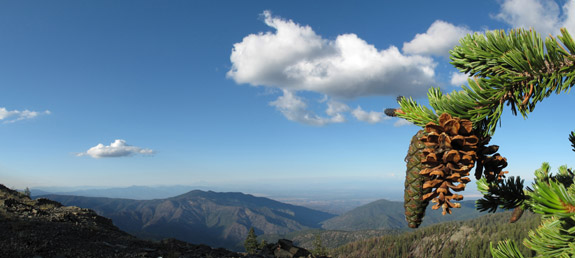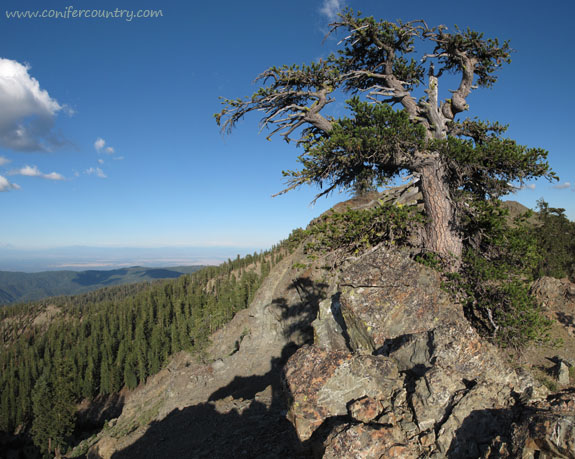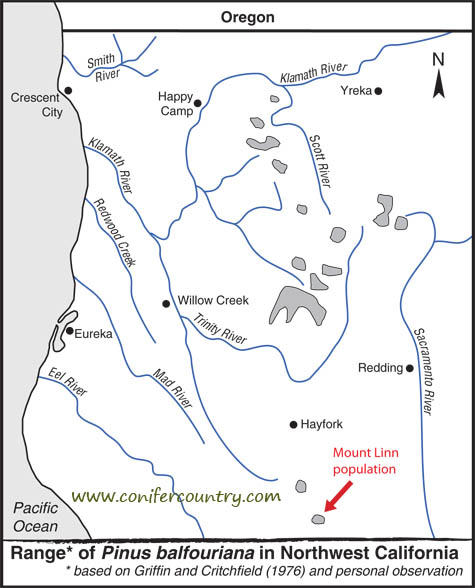Original Publication DATE: 8/10/2009
Mount Linn–also called South Yolla Bolly Mountain–is the highest point in the Coast Range of northern California. It is located to the west of Corning but the area might as well be a world away from the population centers of the state; it is rarely noticed by travelers as they drive Interstate 5. Once off the interstate, scenic forest service roads still take nearly 2 hours to wind to the trailhead. Although this place has always been on my list of places to visit–the impetus for this visit was to collect some samples of the rare Sierra juniper (Juniperus grandis) for Robert Adams of Baylor University so that, through DNA testing, he might find out if these trees truly are what we think they are (see previous blog). After a 25 mile sojourn deep into the wilderness to collect those specimens it was time to search for the southern most stand of foxtail pine in northwest California–on Mount Linn.

The highest summit on South Yolla Bolly Mountain is Mount Linn at 8092 feet, but the exposed ridgeline is nearly a mile long hence the two names. Just below the summit of the main peak is a saddle leading to the second highest peak on the ridgeline–this is where a 10 acre grove of one of the most sublime conifers in the world grows. Here at the southern extent for Pinus balfouriana var. balfouriana they are flourishing, if only on a very restricted and specific site. The grove is nearly pure, with only a few Shasta fir (Abies magnifica var. shastensis), western white pine (Pinus monticola) and Jeffrey pine (Pinus jeffreyi) sharing the windswept ridgeline. It is an idyllic place to wander for both the botanical wonders and endless views (Mount Linn is rated as the 10th best view for any mountain in California.)

Foxtail pines, a California endemic, require a very specific habitat to survive. In northwest California they only grow above 7500 feet on south-facing slopes with a soil substrate that is most often serpentine. When these three factors come together foxtails can flourish. This is also the only population in northwest California that is not in the Klamath Mountains proper (see range map below) but with the lack of competition from other conifers this grove has persisted for millennia.

In California, foxtail pines form two distinct populations separated by more than 300 miles. The southern foxtail pines (var. austrina) grow in the southern Sierra Nevada at elevations above 9500 feet where they form pure stands and attain old age. The northern foxtail pines (var. balfouriana) are isolated on sky islands—defined as local mountain tops and ridgelines—found in the eastern half of the Klamath Mountains and this one spot in the North Coast Range. Here, proper geologic and climatic conditions allow them to compete with the shade-tolerant and faster growing firs and hemlocks (Eckert 2006). This elevational requirement, coupled with soil conditions and drier climate, has allowed isolated populations to persist in the Klamath region after upwards of one million of years of evolutionary divergence between these subspecies (Eckert et al. 2008).

References and Resources:
- Earle, Christopher J., Forest Ecologist, “The Gymnosperm Database”, <https://www.conifers.org>, 9043 Dibble Ave., NW , Seattle, WA 98117
- Eckert, A. J. 2006. Influence of substrate type and microsite availability on the persistence of foxtail pine (Pinus balfouriana, Pinaceae) in the Klamath Mountains, California. American Journal of Botany 93: 1615-1624
- Eckert, A. J., B. R. Tearse, and B. D. Hall. 2008. A phylogeographic analysis of the range disjunction for foxtail pine (Pinus balfouriana, Pinaceae): the role of Pleistocene glaciation. Molecular Ecology.
COMMENT:
AUTHOR: sue
DATE: 3/15/2010 12:40:24 AM
I loved this article.
—–
COMMENT:
AUTHOR: Brynn Nolan
URL: https://www.ccwgrp.org
DATE: 6/7/2010 10:42:00 PM
Michael,
I loved this article! I am the director for the Cottonwood Creek Watershed Group and Mount Linn and the Yolla Bolly’s are in our watershed, so amazing! Can I please have permission to include one or two of your pictures in a brochure that we are putting together? You will be sited!
Brynn- thank you. I love that wilderness and those relict trees. There is also a stand on North Yolla Bolly Peak that is a bit larger. And yes, please use a picture or two–and send me the brochure when you are done! If you need higher quality please email me. -Michael
—–
COMMENT:
AUTHOR: Brynn Nolan
URL: https://www.ccwgrp.org
DATE: 6/9/2010 9:08:19 PM
Thanks Michael! I appreciate your support. Please visit our website at www.ccwgrp.org if you ever get a chance!
—–
COMMENT:
AUTHOR: Robert Self
URL: https://www.hannotrailschool.com
DATE: 6/14/2011 1:08:03 PM
Really enjoyable read! I grew up to the south of the Yolla Bolly’s, in Lake County. As a teenager I dreamed of journeying to all the major Coastal Range summits, though no adults I could find had ever heard of the Yolla Bolly’s! They were just a blank area on the map. Finally, at age 40, I fulfilled my dream of driving to the trailhead and hiking up Mt. Linn. I will certainly do it again as soon as possible (I live in Japan, so not exactly close by!). The next time, I will know what to look for, thanks to this great article!
I also really enjoyed the article and find your book “Conifers of the Pacific Slope” an awesome identification reference for many of my backcountry journeys. I actually snowboarded amongst the foxtail grove on South Yolla Bolly this last spring (see youtube video if interested) and knowing it was the southern most stand of such a unique and interesting species of tree (thanks to this article) made the experience extra special! So thank you very much for the article and information!
Dustin- thanks for contacting me and for using my book(s). I am very impressed to finally “meet” someone who is into mountain sports AND natural history. You need to run with this notion and keep sharing with the hopes of connecting others this way. Well done! I hope our paths cross in the mountains some day.
I’ve been hiking the PCT these last 3 years and will finish the trail the summer of 2015. The summer of 2014 I met a woman in Seiad Valley who was hiking the Bigfoot Trail, she told me about your book, Conifer Country. The trail itself intrigues me but the idea of seeing trees I’ve not heard of before has really captured my imagination. I can’t wait to begin planning the next hike. I put your book on my Christmas list after reading through your posting and can’t wait to open it up and start reading. The photos are beautiful and you’ve added so much detail that I know it will be a fixture in my backpack. I live in Southern Oregon so this feels like it’s in my own backyard. Thank you for sharing your passion!
HI Jane- Thanks for contacting me and for reading my blog. I love long-distance hiking and natural history. The Bigfoot Trail blends them both! Visit bigfoottrail.org and check out the route – email me if you want the route description. Happy trails.
Interesting & detailed article. My 1908 copy of Sudworth’s “Forest Trees of the Pacific Slope” mentions all the sites where they are found in California and includes Township and Range in some places. For Bigfoot Trail area it says ” Confined to California at high elevations on the head of the Sacramento River, of northern Coast Range, and of the southern Sierras. On Scott Mountains, Siskiyou County, at 5,000 to 6,000 feet, Mount Eddy, and Yola Bull (sic) (Tehama County).” Much more detail about the Sierras.
David Rains Wallace in his “The Klamath Knot” mentions Foxtail Pines in reference to the Russian Peak area. His book is a good read for anyone interested in the Bigfoot Trail.
Thanks for the note Susan. Love the foxtail pine and the sky islands on which they grow!
Great reading and pictures, I live in corning ca and get to see these mountains and wilderness all the time, I really enjoyed reading this article.
Thanks for citing these beatiful and unique conifers that are closely related to the Ancient Brisilecone pines. All of the groves are worth visiting. Thanks for your contribution to bring awareness to conifers and their companion plants and trees. Darshan Mayginnes, Formally the director of the Rare Conifer Foundation.